The Californians: A Federal Court in the Golden State Weighs in on the Economic-Loss Rule
I am always curious to see how courts outside of North Carolina grapple with section 75-1.1—particularly when facing novel or unsettled questions. And few questions are as unsettled as whether the economic-loss rule bars a section 75-1.1 claim. In fact, we have discussed opinions from outside of our state (California and Massachusetts) that reached opposite conclusions on this question.
A recent decision from the United States District Court for the Northern District of California adds to the number of opinions refusing to apply the economic-loss rule and gives us a window into how other jurisdictions construe North Carolina law. With apologies in advance to the talented creators, writers, and actors of Saturday Night Live’s The Californians, I invite you to reflect on Sloan v. General Motors with me. Like Karina, Stuart, and Rosa gazing inquisitively into the same mirror, we’ll search for hidden insights in the decision.
Trouble on the 10 and the Ventura Freeway
 Sloan is a class action brought by GM car owners who claim that their cars’ engines were knowingly manufactured with an inherent defect that caused them to consume excessive amounts of oil. Like Trey explaining his route through the Simi Valley to Devin, the decision recites the resulting mechanical difficulties in excruciating detail. The class representatives’ depositions painted grim pictures of worn camshafts, fouled spark plugs, damaged piston rings, engine seizure, and outright engine failure.
Sloan is a class action brought by GM car owners who claim that their cars’ engines were knowingly manufactured with an inherent defect that caused them to consume excessive amounts of oil. Like Trey explaining his route through the Simi Valley to Devin, the decision recites the resulting mechanical difficulties in excruciating detail. The class representatives’ depositions painted grim pictures of worn camshafts, fouled spark plugs, damaged piston rings, engine seizure, and outright engine failure.
Evidence suggested that GM knew about the defect that led to these problems, but failed to warn its customers. Left stranded on the sides of highways and burning through quarts of motor oil (literally), the customers were furious.
The Sloan plaintiffs sought to have several classes certified, including one class comprised of North Carolinians who purchased or leased the affected GM vehicles. The North Carolina Class brought claims for violations of section 75-1.1, violations of the Magnuson-Moss Warranty Act (MMWA), breach of the implied warranty of merchantability, fraudulent omission, and unjust enrichment.
What are You Doing Here? Take Your Tort Claims Back to the 405, Head North to Wilshire, and Dump Them Off at San Vincente Where They Belong!
GM moved for summary judgment, arguing a variety of theories. GM argued that the claims were barred by the applicable statutes of limitation, the economic-loss rule, the absence of a duty to disclose, and the absence of a predicate claim to support MMWA liability. GM also sought summary judgment on the unjust enrichment claims, arguing that the equitable claims were barred where adequate legal remedies existed. Ultimately, only one of GM’s arguments was successful against the North Carolina Class’s claims—on unjust enrichment. Otherwise, the court rejected GM’s arguments and denied summary judgment.
Although the court’s analysis of each of the claims is worth reading, we’ll limit today’s focus on one of our favorite topics: the application of North Carolina’s economic-loss rule to section 75-1.1.
Sit Down on These Neutral-Toned Ranch-Style Chairs So We Can Discuss This Over Sun-Dried Tomatoes
The Sloan court recognized that North Carolina’s economic-loss rule “prohibits the purchaser of a defective product from using tort law to recover purely economic losses.” But Sloan held that the rule could not be used to bar a section 75-1.1 claim.
This holding undoubtedly surprised GM, as Stuart is always surprised to find Devin in his house. After all, GM had cited no fewer than five decisions from the federal courts in North Carolina that applied the economic-loss rule to bar section 75-1.1 claims, including one that also involved a defective motor vehicle: Malone v. Tamko Roofing Products, Wireless Communications v. Epicor Software, Mecklenburg County v. Nortel, Butcher v. DaimlerChrysler, and Watson v. Fleetwood Motor Homes. Sloan itself cited a sixth: Bussian v. DaimlerChrysler. And, regular readers of this blog could point to even more federal court decisions in North Carolina with the same holding. (See, e.g., here and here.)
Sloan declined to follow these federal decisions, though, explaining that the court “must be guided primarily by the decisions of North Carolina’s state courts.” Sloan reminded the parties that when a federal court interprets state law, it endeavors to “approximate state law as closely as possible.” Where the highest court of a state has not ruled—as the North Carolina Supreme Court had not—the federal court will follow the decisions of the state’s intermediate appellate courts, unless it has reason to believe that the highest court would hold differently.
Is that Mick Jagger I See at the Ferris Wheel on Santa Monica Pier? No, but I Do See Two Future North Carolina Supreme Court Justices.
Interestingly, but without noting the fact, Sloan examined two North Carolina Court of Appeals opinions that happened to be authored by current members of the North Carolina Supreme Court: then-Judge Hudson’s dissent in Coker v. DaimlerChrysler and then-Judge Beasley’s decision in Buffa v. Cygnature Construction.
The Coker majority declined to reach the economic-loss-rule issue because it concluded that the plaintiffs lacked standing. In a dissenting opinion, however, then-Judge Hudson explained that she would have reached the question and held that the economic-loss rule could not bar a section 75-1.1 claim. She reasoned that section 75-1.1 provided a legislative remedy that a judicial rule (like the economic-loss rule) could not foreclose.
Sloan quoted from the Coker dissent extensively and found its reasoning persuasive. In concluding that it reflected the current state of North Carolina law, Sloan reasoned that “only [then-]Judge Hudson . . . spoke directly to the question here.” As persuasive as the opinion was, though, it was a dissent. And, it was considered, but not accepted by the North Carolina Supreme Court, which affirmed the Coker majority per curiam. The Sloan court never addressed the effect of the Supreme Court’s affirmance. (In fact, Sloan is the third time that the same court has relied on the dissent to reach the same result. It also did so in In re Chrysler-Dodge-Jeep Ecodiesel and In re MyFord Touch. We wrote about MyFord Touch and its failure to address the Supreme Court’s affirmance of Coker.)
Buffa, by contrast, endorses the application of the economic-loss rule to bar a section 75-1.1 claim. The Buffa plaintiffs brought a section 75-1.1 claim arising out of their purchase of allegedly defective windows. The trial court entered summary judgment for the defendant on the claim, expressly applying the economic-loss rule. The claimant argued that this was error, but Buffa disagreed and affirmed. Although the Court of Appeals’ discussion disposing of the section 75-1.1 claim did not discuss its reasoning in economic-loss-rule terms, it did turn on the fact that the section 75-1.1 claim was “in essence a claim for breach of warranty.” The existence of a warranty (or other contract), after all, is the very rationale for the rule.
How could Sloan avoid Buffa’s holding? By distinguishing the case. Sloan pointed out that Buffa involved no evidence of a systematic design flaw or failure in the windows to suggest that the defendants were engaged in deceit—the “substantial aggravating circumstances” alleged in that case. According to Sloan, therefore, Buffa did not resolve the precise question presented by the GM customers complaining of excessive oil consumption: “where . . . there is evidence of both a defect and a deceptive act, does the economic loss rule apply to [section 75-1.1] claims?” Without further analysis, Sloan put Buffa aside and held that the economic-loss rule would not bar the North Carolina Class plaintiffs’ section 75-1.1 claims.
Broken Hearted Along the 118 and the 5
Like many cases before it, Sloan underscores the need for development of state appellate court jurisprudence on the economic-loss rule’s relationship to section 75-1.1. Until we have a clear pronouncement from the North Carolina Supreme Court, lower courts here at home and courts in other jurisdictions will continue to leave a trail of differing results—like the broken hearts Devin has left in Rancho Cucamonga, San Bernardino, Santa Clarita, and Redondo Beach. With appeals from the North Carolina Business Court—which frequently opines on this question—going directly to the Supreme Court, there is reason to hope that we’ll have such a pronouncement soon.
Author: Tom Segars


